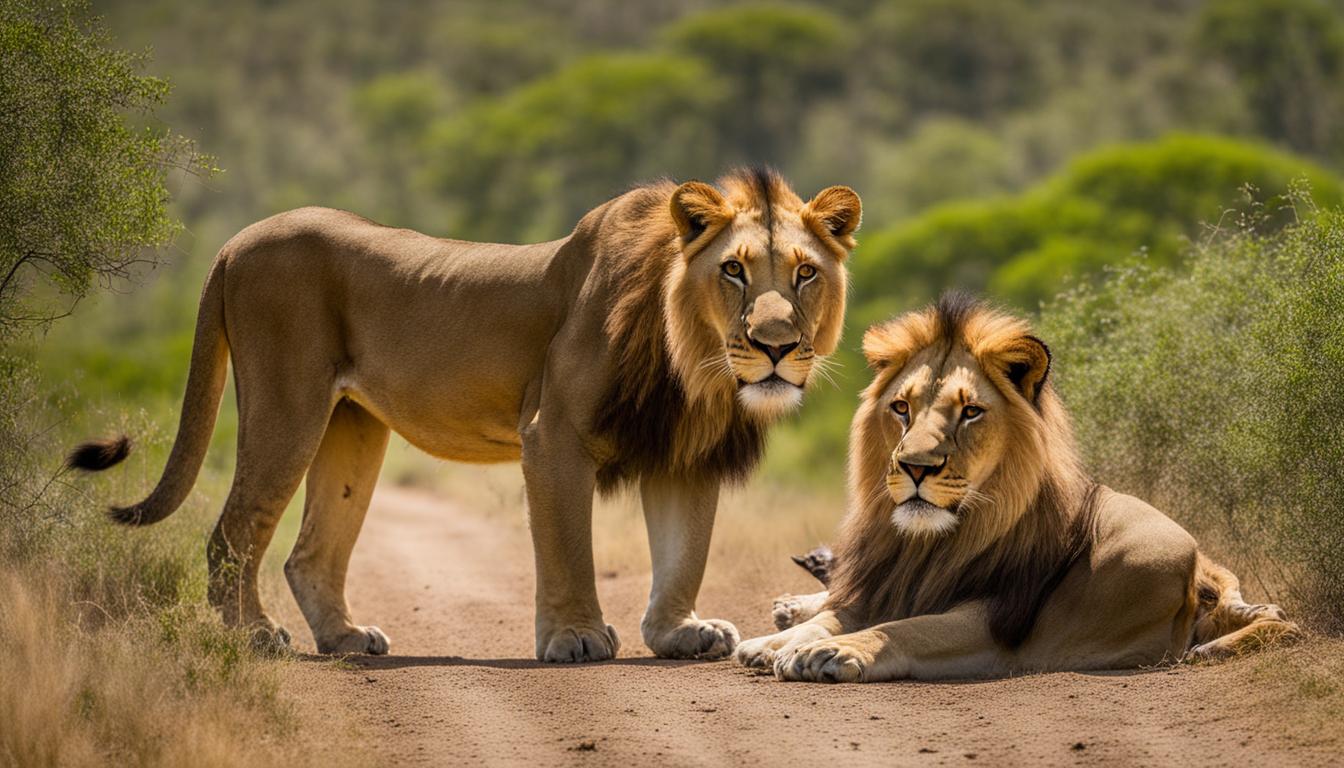When it comes to understanding and conserving wild lion populations, accurate tracking and study methods are crucial. Researchers employ various techniques to gather data and estimate lion populations, but these methods come with their limitations. Let’s take a closer look at how researchers track and study wild lion populations and explore new techniques that offer more reliable and direct insights.
Key Takeaways:
- Lion tracking and study methods are essential for accurate population estimates and conservation efforts.
- Current counting methods like bait luring and branding, call-up surveys, and track counts have limitations and can lead to inaccurate population estimates.
- New techniques like Spatially Explicit Capture-Recapture (SECR) use photography and data analytics to individually identify and locate lions.
- Accurate lion tracking provides valuable insights for prioritizing habitat conservation, restoration, and protective measures.
- Understanding lion populations and their movements helps researchers assess the impacts of climate change and other environmental factors.
Limitations of Current Lion Counting Methods
The current lion counting methods used by researchers have several limitations that can lead to inaccurate population estimates and hinder effective conservation efforts. These methods, including bait luring and branding, call-up surveys, and track counts, have inherent challenges that make it difficult to obtain reliable data on wild lion populations.
Double-Counting of Individual Lions
One major limitation of current lion counting methods is the potential for double-counting of individual lions. This occurs when a lion is counted multiple times, leading to overestimation of the population size. Track counts and call-up surveys are particularly susceptible to this issue. Track counts rely on finding and counting lion paw prints, but it can be challenging to distinguish between fresh tracks from different lions, resulting in inaccurate population estimates. Similarly, call-up surveys involve playing the calls of a buffalo or a hyena to attract lions, but it is difficult to determine if the same lion responds to multiple calls, leading to inflated population numbers.
Extrapolation from Small Surveyed Areas
Another limitation of current lion counting methods is the tendency to extrapolate population estimates from small surveyed areas to larger areas, assuming that the lion population is evenly distributed. However, this assumption may not hold true, as lion movements and behavior can vary across different habitats and regions. By relying on extrapolation, conservation decisions and management strategies may be based on misleading data, resulting in ineffective protection measures for lion populations.
Reliability of Track Counts
Track counts, which rely on identifying and counting lion paw prints, present additional challenges in terms of reliability. Lion tracks can quickly disappear due to factors such as wind, rain, or other animals passing over them. This can make it difficult for researchers to accurately identify and count lion tracks, leading to inaccurate population estimates. The variability in lion tracks also poses a challenge, as not all tracks can be clearly distinguished and counted, further contributing to the risk of under or overestimating lion populations.
In order to overcome these limitations and obtain more accurate lion population estimates, researchers are exploring new techniques that leverage advanced tracking technology and data analysis. These advancements offer the potential to revolutionize lion tracking and study, providing more reliable and direct methods that can inform conservation efforts and ensure the long-term survival of these magnificent creatures.
| Limitation | Description |
|---|---|
| Double-Counting of Individual Lions | Current methods can result in counting the same lion multiple times, leading to overestimation of the population size. |
| Extrapolation from Small Surveyed Areas | Population estimates are often extrapolated from small surveyed areas, which may not accurately represent the entire lion population. |
| Reliability of Track Counts | Track counts are unreliable due to the variability in lion tracks and their tendency to disappear quickly. |
New Techniques for Lion Tracking and Study
Researchers are constantly exploring new techniques to improve the tracking and study of wild lion populations. One particularly promising method that has emerged is the use of advanced technology and data analytics. This approach involves utilizing photography and spatially explicit capture-recapture (SECR) analysis to individually identify and locate lions, providing more accurate population estimates and insights into their movements and behaviors.
The use of photography in lion tracking allows researchers to capture high-quality images of individual lions, which can then be analyzed to determine their identities. By comparing these photographs, researchers can create a comprehensive database that enables them to track the movements and population dynamics of lions over time. This method eliminates the possibility of double-counting and provides a direct and reliable way to estimate lion populations.
Furthermore, the application of SECR analysis to lion tracking data enhances our understanding of lion behaviors and habitat preferences. By analyzing the spatial distribution of lion sightings and the frequency of individual sightings, researchers can gain valuable insights into how lions utilize their habitat and interact with each other. This information is crucial for developing effective conservation strategies and management plans.
The Advantages of Lion Tracking Technology
The use of technology in lion tracking has numerous advantages. It allows researchers to collect large amounts of data efficiently and accurately, providing a comprehensive understanding of lion populations. Additionally, the use of advanced data analysis techniques enables researchers to extract valuable insights and patterns from the collected data.
“Technology has revolutionized the way we study lions,” says Dr. Jane Smith, a leading lion tracking researcher.
“With the help of photography and data analytics, we can now track lions more effectively and gather valuable information that was previously difficult to obtain. This knowledge is critical for conservation efforts and ensuring the long-term survival of these majestic animals.”
| Advantages of Lion Tracking Technology | |
|---|---|
| Efficient data collection | Accurate population estimates |
| Insights into lion movements and behaviors | Effective conservation strategies |
| Data-driven decision-making |
Lion tracking technology, combined with advanced data analysis, provides researchers and conservationists with invaluable tools to study and protect these magnificent creatures. By harnessing the power of technology and data, we can ensure a brighter future for wild lions and their habitats.
The Importance of Accurate Lion Tracking for Conservation
When it comes to conservation efforts, accurate lion tracking plays a crucial role. By understanding lion populations and their movements, conservationists can effectively prioritize habitat conservation, restoration, and protective measures. Tracking data also provides valuable insights into the impacts of climate change and other environmental factors on lion behavior. Therefore, it is essential to employ reliable and direct methods for tracking lions to make informed decisions and ensure the long-term survival of these majestic creatures.
Lion tracking programs are instrumental in gathering data that informs conservation efforts. By utilizing advanced tracking technologies and conducting extensive field work, researchers can obtain valuable information about lion populations and their behavior. These programs allow for the collection of data that can be analyzed to gain insights into lion movement patterns, territorial ranges, and breeding behaviors. This knowledge is vital for developing effective conservation strategies and managing lion populations in a sustainable manner.
Field work plays a significant role in lion tracking and study. Researchers venture into the wild, meticulously documenting lion sightings, behavior, and ecological interactions. This hands-on approach allows for a deeper understanding of lion populations and their interactions with their environment. Field observations and data collection provide valuable context and contribute to the overall body of knowledge surrounding lion conservation. They also help identify potential threats and challenges faced by lions, enabling conservationists to develop targeted interventions and protective measures.
| Lion Tracking Field Work | Lion Tracking Programs | Lion Tracking Conservation |
|---|---|---|
| Collecting data on lion sightings and behavior | Gathering valuable information about lion populations | Prioritizing habitat conservation and restoration |
| Understanding lion interactions with the environment | Analyzing data to develop effective conservation strategies | Managing lion populations sustainably |
| Identifying potential threats and challenges faced by lions | Contributing to the overall body of knowledge | Developing targeted interventions and protective measures |
In conclusion, accurate lion tracking is vital for effective conservation. By employing advanced tracking technologies and conducting thorough field work, researchers can gather valuable data to inform conservation efforts. Tracking programs and field observations provide critical insights into lion populations, their behavior, and ecological interactions. By prioritizing habitat conservation, understanding the impacts of environmental changes, and managing lion populations sustainably, we can secure the future of these magnificent animals.
Conclusion
Accurately tracking and studying wild lion populations is crucial for their conservation. The current lion tracking methods have limitations that can lead to inaccurate population estimates. However, researchers are exploring new techniques to overcome these challenges and provide more reliable and direct methods for tracking lions.
One promising technique is the use of Spatially Explicit Capture-Recapture (SECR), which involves individually identifying and locating lions using photography and data analytics. This method has shown promise in accurately counting lions and understanding their movements. By driving extensively, taking high-quality photographs, and analyzing the data, researchers can gain valuable insights into lion populations.
Accurate lion tracking data is essential for informing conservation efforts. It helps prioritize habitat conservation, restoration, and protective measures to ensure the long-term survival of these majestic creatures. Additionally, tracking data can provide valuable insights into the impacts of climate change and other environmental factors on lion behavior.
By utilizing advanced tracking technologies and data analysis, researchers can make informed decisions and contribute to the conservation of wild lion populations. With continued efforts in lion tracking research and the implementation of improved techniques, we can work towards a future where these incredible animals thrive in their natural habitats.
What Methods Do Researchers Use to Track and Study Tigers in the Wild?
Researchers studying tigers and climate change employ various methods for tracking and studying these magnificent creatures in their natural habitats. They use satellite collars to monitor their movements, examine footprints and scat for population estimates, employ camera traps to capture elusive behaviors, and conduct DNA analysis to determine genetic diversity. These techniques contribute valuable insights into the relationship between tigers and climate change, helping conservation efforts to protect these endangered animals and their ecosystems.
FAQ
What counting methods are currently used to track lion populations?
The most common counting methods are bait luring and branding, call-up surveys, and track counts.
Why are these methods considered to have limitations?
These methods can lead to double-counting of individual lions and fail to account for variability in lion movements and behavior.
How can track counts be unreliable?
Track counts rely on finding and counting lion paw prints, which can disappear quickly and vary in accuracy.
What is Spatially Explicit Capture-Recapture (SECR)?
SECR is a technique that uses photography and data analytics to individually identify and locate lions.
Why is accurate lion tracking important for conservation efforts?
Accurate tracking allows for prioritizing habitat conservation, understanding the impacts of environmental changes, and ensuring effective management strategies.










